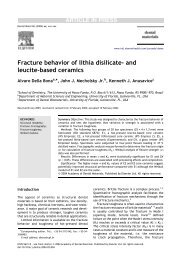Micro-tensile bond strength of adhesives bonded to class-I cavity ...
Micro-tensile bond strength of adhesives bonded to class-I cavity ...
Micro-tensile bond strength of adhesives bonded to class-I cavity ...
Create successful ePaper yourself
Turn your PDF publications into a flip-book with our unique Google optimized e-Paper software.
<strong>Micro</strong>-<strong>tensile</strong> <strong>bond</strong> <strong>strength</strong> <strong>of</strong> <strong>adhesives</strong> <strong>bond</strong>ed <strong>to</strong> <strong>class</strong>-I <strong>cavity</strong>-bot<strong>to</strong>m dentin after thermo-cycling 1001<br />
Table 1 Adhesives used.<br />
Adhesive Composition Application<br />
OptiBond FL Etchant: 37.5% phosphoric acid,<br />
Apply the etchant for 15 s; rinse for 15 s; gently<br />
(Kerr, Orange, silica thickener [301194]<br />
air dry for 5 s; scrub the surface for 15 s with<br />
CA, USA) Primer: HEMA, GPDM, PAMM, ethanol, water, primer; apply a thin coat <strong>of</strong> <strong>bond</strong>ing agent and<br />
pho<strong>to</strong>initia<strong>to</strong>r [212652]<br />
Bond: TEGDMA, UDMA, GPDM, HEMA, bis-GMA,<br />
filler, pho<strong>to</strong>initia<strong>to</strong>r [301335]<br />
light cure for 30 s<br />
Protect Bond Primer: MDP, MDPB, HEMA, initia<strong>to</strong>r, water Apply the primer for 20 s using a rubbing<br />
(Kuraray, [ABB-002]<br />
motion; gently air dry; apply the <strong>bond</strong>ing<br />
Osaka, Japan) Bond: MDP, HEMA, dimethacrylates, colloidal<br />
SiO2, surface treated NaF, initia<strong>to</strong>r [ABP-001]<br />
agent; light cure for 10 s<br />
iBOND (Heraeus Adhesive: UDMA, 4-MET, gluteraldehyde, Apply in three consecutive times and rub for<br />
Kulzer, Hanau, ace<strong>to</strong>ne, water, stabilizer, pho<strong>to</strong>initia<strong>to</strong>r 30 s; gentle air dry until adhesive moves no<br />
Germany) [010028]<br />
more; thoroughly air dry for 5 s; light cure<br />
for 20 s<br />
Bis-GMA, bisphenol-glycidyl methacrylate; GPDM, glycerol phosphate dimethacrylate; HEMA, 2-hydroxyethylmethacrylate; MDP,<br />
10-methacryloyloxydecyl dihydrogen phosphate; MDPB, 12-methacryloyloxydodecylpyridinium bromide; PAMM, phthalic acid<br />
monoethyl methacrylate; TEGDMA, triethylene glycol dimethacrylate; UDMA, urethane dimethacrylate; 4-MET, 4-methacryloyloxyethyl<br />
trimellitic acid.<br />
USA). Light-curing was performed using a highpower<br />
LED curing device (L.E.Demetron 1, Demetron/Kerr,<br />
Danbury, CT, USA).<br />
Then, the res<strong>to</strong>red cavities were sectioned<br />
perpendicular <strong>to</strong> the adhesive–<strong>to</strong>oth interface<br />
using an Isomet diamond saw (Isomet 1000,<br />
Buehler Ltd, Lake Bluff, IL, USA) <strong>to</strong> obtain<br />
rectangular sticks (1.8!1.8 mm wide; 8–9 mm<br />
long). Out <strong>of</strong> each <strong>to</strong>oth, four sticks were<br />
sectioned from the central <strong>cavity</strong> floor (Fig. 1).<br />
They were mounted in the pin-chuck <strong>of</strong> the<br />
<strong>Micro</strong>Specimen Former and trimmed at the biomaterial–<strong>to</strong>oth<br />
interface <strong>to</strong> a cylindrical hour-glass<br />
Figure 1 Schematic study design.<br />
shape with a <strong>bond</strong>ing surface <strong>of</strong> about 1 mm 2 using<br />
a fine cylindrical diamond bur (835KREF, Komet,<br />
Lemgo, Germany) in a high-speed handpiece under<br />
air/water spray coolant. Specimens were then fixed<br />
<strong>to</strong> Ciucchi’s jig with cyanoacrylate glue (Model<br />
Repair II Blue, Sankin Kogyo, Tochigi, Japan)<br />
and stressed at a crosshead speed <strong>of</strong> 1 mm/min<br />
until failure in a LRX testing device (LRX, Lloyd,<br />
Hampshire, UK) using a load cell <strong>of</strong> 100 N. The mTBS<br />
was expressed in MPa, as derived from dividing<br />
the imposed force (N) at the time <strong>of</strong> fracture by the<br />
<strong>bond</strong> area (mm 2 ). When specimens failed before<br />
actual testing, the mTBS was determined from
















